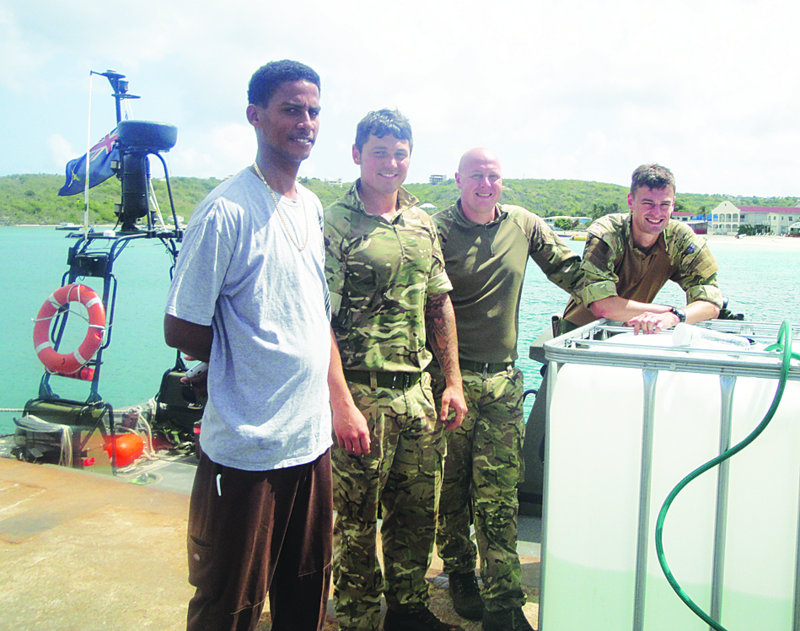

After many years of discussion and planning, there has now been a tangible effort to bring on stream the Fountain National Park, with the historic Amerindian Fountain Cavern at Shoal Bay East as the centerpiece of attraction for tourists as well as Anguillians who ought to know and celebrate their rich cultural history.
One of the first concrete step towards the creation and establishment of the above National Park was taken on Saturday, July 25, when there was a soft opening of phase one. That phase includes a leveled parking lot, entryway, reception centre, trail, interpretative signage, displays, toilet, and a waste water treatment plant. The thatched roof covering of the reception centre was specially sourced on Dominica from thatch farmers and the Kalinago tribe.

The event, at which the ribbon was cut by Governor Christina Scott, and Chief Minister and Minister of Economic Development and Tourism, Mr. Victor Banks, was witnessed by a large cross-section of the community. The gathering included Government officials, members of the Anguilla Historical and Archaeological Society, and a group of persons who were involved in the preparatory work – on the site – which commenced in May this year.
Phase two of the project will be the construction of an interpretation centre depicting a large hut used by the Taino people who inhabited the island. The centre will house various artifacts from the Fountain Cavern as well as casts, fossils and information on one of the first inhabitants of Anguilla – the Amblyrhiza Inundata or Anguilla’s Giant Rodent which is now extinct. For the time being, some of these artifacts are displayed in the reception centre.
Among the exhibits are a number of scientific replicas, made in the United States, of body parts of the Amblyrhiza Inundata. The replicas were made from a polyester resin, the material commonly used for research casting. They include six pieces comprising thigh and skull bones. Although all the pieces are not available for a complete skeleton, the replicas provide a good sense of the size of the Amblyrhiza.
Permanent Secretary, in the Ministry of Economic Development and Tourism, Mr. Foster Rogers, told the gathering that the Fountain National Park and Interpretation Centre and Trail had been under consideration for many years and had now reached the stage of a soft opening of the first phase. “We have called it a soft opening for two reasons,” he explained. “Phase one is nearing completion, and phase two commences within the next two weeks. The Fountain is an incredible national resource for Anguilla. Amerindians discovered the cavern 1500 years ago and used it as a fresh water source and a ceremonial site.”
Mr. Rogers commended a number of workmen, and other persons, for their continuing contribution to the Fountain National Park, Interpretation Centre and Trail.
Chief Minister Banks said the project was something that Anguilla was looking forward to for a long time to help market the island. “We have very huge sites of this nature that we can develop and showcase, and today I am proud of the team led by the Ministry of Tourism and the Environment for the work that they have done…The Archaeological and Historical Society was also very much involved.”
When the visiting archaeologists arrived at the Fountain Cavern, they were greeted by Mr. Gerard LanGlais, a Ceremonial Priest of the Kalinago Tribe in the Commonwealth of


 Dominica who is very passionate about the Caribbean’s Amerindian culture. He is also a teacher of music and dance of the Kalinago, the indigenous people of Dominica, having one of the closest links to the Taino people who once lived in Anguilla. He performed a ritual as onlookers stood outside the fenced area of the Fountain Cavern. Some of them also entered the enclosure with him for a peak into the cavern.
Dominica who is very passionate about the Caribbean’s Amerindian culture. He is also a teacher of music and dance of the Kalinago, the indigenous people of Dominica, having one of the closest links to the Taino people who once lived in Anguilla. He performed a ritual as onlookers stood outside the fenced area of the Fountain Cavern. Some of them also entered the enclosure with him for a peak into the cavern.
The Fountain National Park covers an area of 14.5 acres and comprises a series of limestone terraces rising from sea level to 92 feet. The Fountain Cavern is currently covered as work continues on the National Park.










